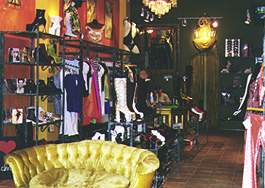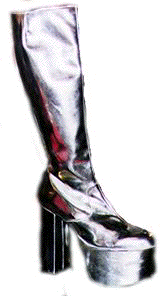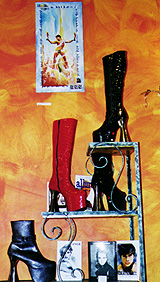 The walls are different hues of
orange, hand painted in a swirling spongy texture, while the tall ceiling
looks industrial with its black pipes and hanging metal lights. Additional
lights are on the walls in the form of simple, geometric sconces, and the
floor is terra cotta tile. I immediately felt welcomed by a casual setup of
armchairs and a sofa around a low coffee table at the front end of the store,
where a man sat reading a catalogue and snacking from a can of Cheez Curls.
I was surprised to see that besides myself, he was the only other person in
the store. He looked up at me and gave me an authentic smile, saying hello;
he appeared to be in his early 30s, stylishly dressed in a Calvin Klein shirt,
jeans and a black baseball cap with "Zero" on the front. I ended up sitting
down to talk with him, as he, Javier Font, is the owner of
iT, a shop
claiming to offer shoes, fashion, gifts, furniture, accessories, art,
jewelry and antiques. He was eager to share with me the store's interesting
history, speaking in his strong Spanish accent.
The walls are different hues of
orange, hand painted in a swirling spongy texture, while the tall ceiling
looks industrial with its black pipes and hanging metal lights. Additional
lights are on the walls in the form of simple, geometric sconces, and the
floor is terra cotta tile. I immediately felt welcomed by a casual setup of
armchairs and a sofa around a low coffee table at the front end of the store,
where a man sat reading a catalogue and snacking from a can of Cheez Curls.
I was surprised to see that besides myself, he was the only other person in
the store. He looked up at me and gave me an authentic smile, saying hello;
he appeared to be in his early 30s, stylishly dressed in a Calvin Klein shirt,
jeans and a black baseball cap with "Zero" on the front. I ended up sitting
down to talk with him, as he, Javier Font, is the owner of
iT, a shop
claiming to offer shoes, fashion, gifts, furniture, accessories, art,
jewelry and antiques. He was eager to share with me the store's interesting
history, speaking in his strong Spanish accent.
 as Javier's friend owns the business that provides the store's many styles of
platform shoes and boots. With its factory in Spain, Linchini now has sales
outlets in New York, Amsterdam, Paris and Germany, regularly shipping shoes
to Miami's iT store. The shoe styles are valuable
to drag queens, Javier
explained, since they are made in large sizes for both men and women's feet,
which is quite unusual for high heels. Looking around the store, I saw a
wide range of unique and appealing designs, the sizes striking me as
abnormally large for their look: six-inch high heels in patent leather red,
silver glitter, shiny black, rusty orange/gold and almost every other color
of the rainbow, as well as boots in varying heights (up to a full-leg
thigh-high style).
as Javier's friend owns the business that provides the store's many styles of
platform shoes and boots. With its factory in Spain, Linchini now has sales
outlets in New York, Amsterdam, Paris and Germany, regularly shipping shoes
to Miami's iT store. The shoe styles are valuable
to drag queens, Javier
explained, since they are made in large sizes for both men and women's feet,
which is quite unusual for high heels. Looking around the store, I saw a
wide range of unique and appealing designs, the sizes striking me as
abnormally large for their look: six-inch high heels in patent leather red,
silver glitter, shiny black, rusty orange/gold and almost every other color
of the rainbow, as well as boots in varying heights (up to a full-leg
thigh-high style).
 Rachel Bowlby emphasizes the important
role of the sales clerk, claiming that s/he plays a part in every stage of
the consumer's experience: Attraction, Interest, Desire and Sale (104).
These stages have their climax at "the meeting," a moment when the
prospective buyer's mind is set apart from his/her environment, a time when,
ideally, the situation is "sealed off so that nothing can make its way into
the buyer's mind but what you, the salesperson, put into it or make up for
it" (103). Looking at iT, we can see that the inverse is
actually true, as
the actual salesperson shifts his/her responsibility of sale to the store's
captivating spectacle of images. Unlike the salespeople of The Ladies
Paradise, Javier does not want to interrupt the consumer's relationship with
the commodities on display, thus he plays a quiet role of observation. This
reality actually embodies Bowlby's definition of the
climactic moment, yet just with different players, as the store's displays
act the part of the salesperson.
Rachel Bowlby emphasizes the important
role of the sales clerk, claiming that s/he plays a part in every stage of
the consumer's experience: Attraction, Interest, Desire and Sale (104).
These stages have their climax at "the meeting," a moment when the
prospective buyer's mind is set apart from his/her environment, a time when,
ideally, the situation is "sealed off so that nothing can make its way into
the buyer's mind but what you, the salesperson, put into it or make up for
it" (103). Looking at iT, we can see that the inverse is
actually true, as
the actual salesperson shifts his/her responsibility of sale to the store's
captivating spectacle of images. Unlike the salespeople of The Ladies
Paradise, Javier does not want to interrupt the consumer's relationship with
the commodities on display, thus he plays a quiet role of observation. This
reality actually embodies Bowlby's definition of the
climactic moment, yet just with different players, as the store's displays
act the part of the salesperson.